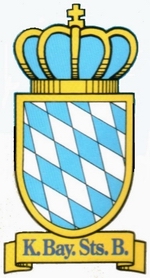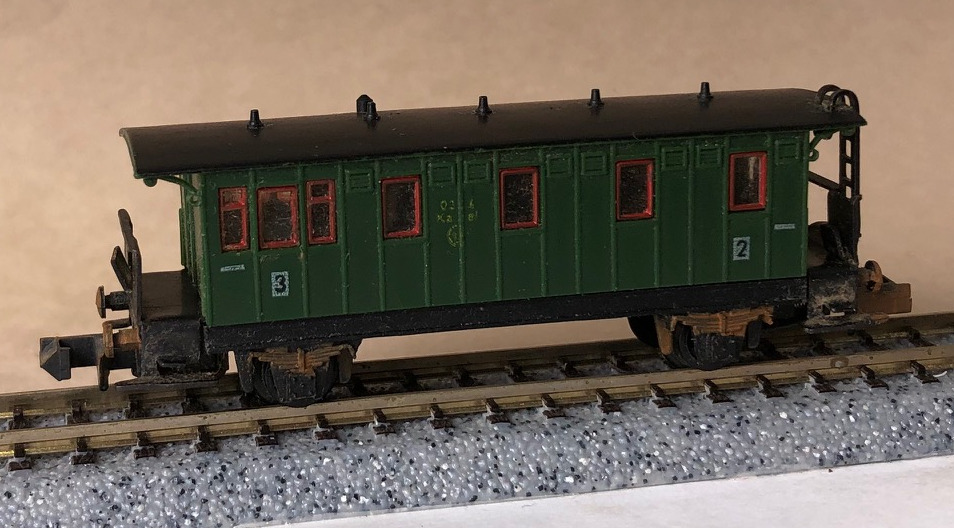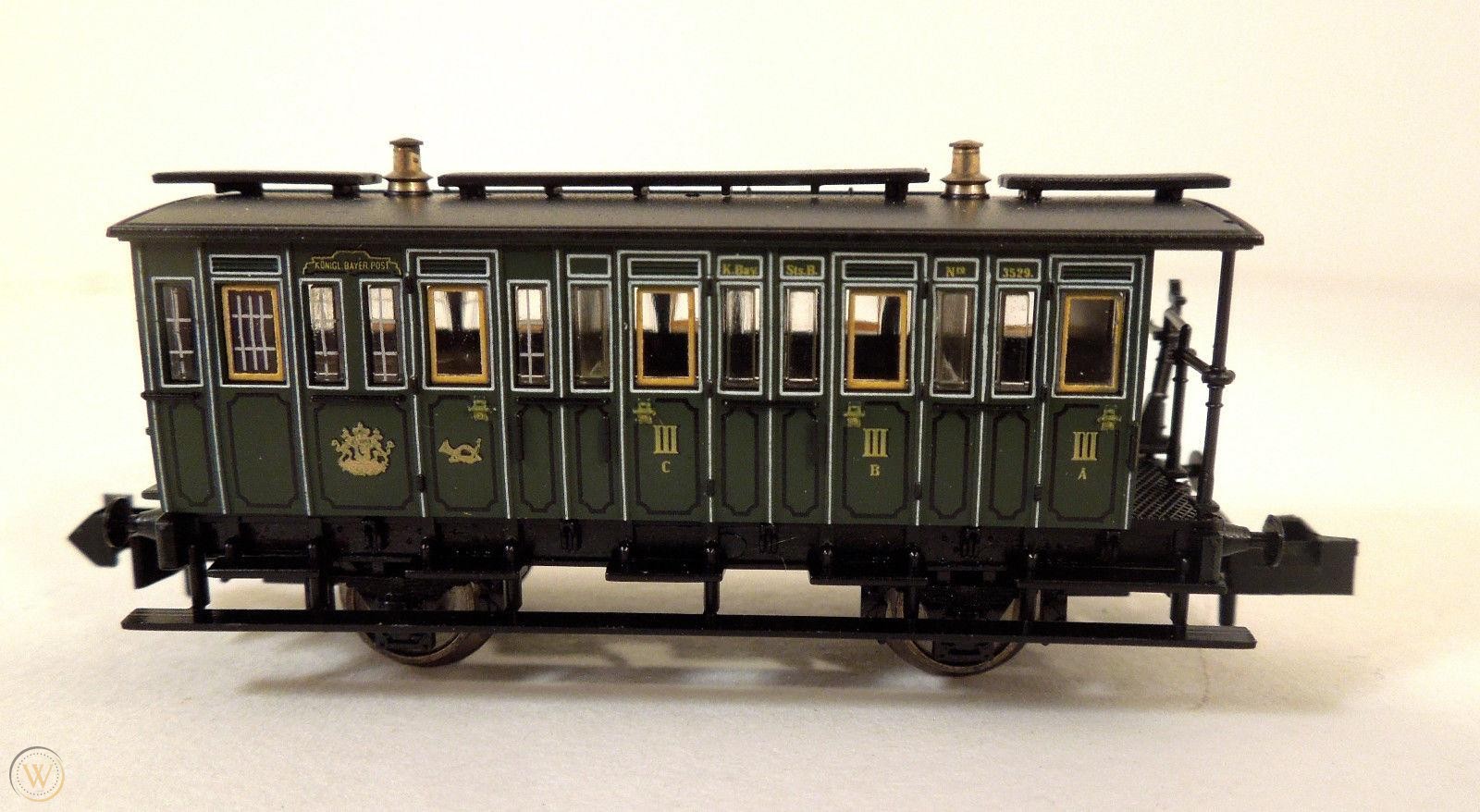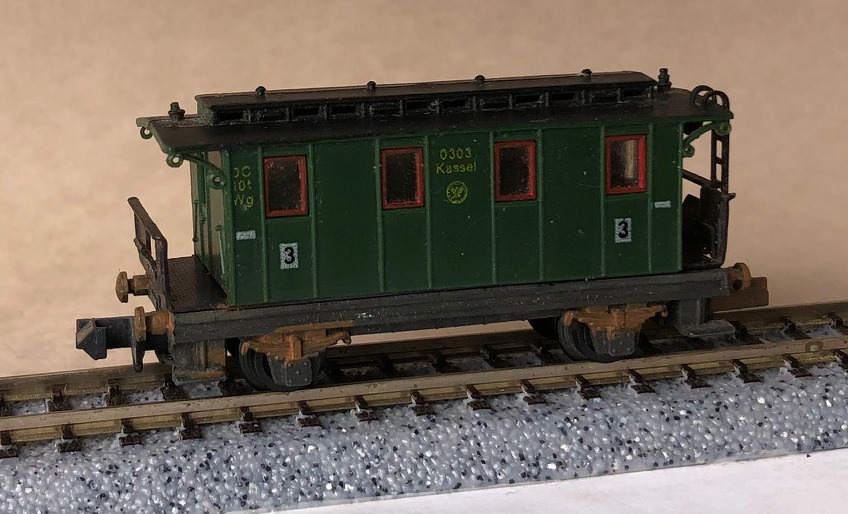Prototype History: The Bavarian Class Gt 2×4/4 (bayerische Gt 2x4/4) engine of the Royal Bavarian State Railways (Königlich Bayerische Staats-Eisenbahnen or K.Bay.Sts.B.), was a heavy goods train tank locomotive of the Mallet type. It was later designated the DRG Class 96 (Baureihe 96) by the DRG, DB and DR.
The Gt 2x4/4 Mallet locomotive was equipped with two sets of compound-configured running gear, the front one, pivoted on a 15 cm thick coupling pin, had large low-pressure cylinders, and the rear one, which was fixed, had smaller high-pressure cylinders. Both had one driven and three coupled axles. The designer of this heavy locomotive was the then senior engineer and director at Joseph Anton von Maffei, Anton Hammel, (1857-1925), who had also developed the famous S 3/6. Between 1913 and 1914 the first series of 15 vehicles was procured and they entered service in 1914. The locomotives caused quite a stir at that time and could be seen at the railway exhibitions frequently held in those days (e.g. the 1922 transport exhibition in Munich) - and, like the S 3/6, they were often painted with a blue or ochre yellow photographic livery and adorned with a crowned chimney. As the first one of the second series, no. 5766 (96 016) was even spruced up with brass bands on the crowned chimney and boiler as well as brass decorations on its front cylinders, and certainly made an impression. A similar thing was carried out on the same locomotive after the rebuilding of the second series in 1926. Otherwise, the first series had a narrow chimney with a cap similar to the Prussian P 8. The operational livery of the K.Bay.Sts.B. locomotives was green with yellow lettering and a black chassis.
The Gt 2x4/4 Mallet locomotive was equipped with two sets of compound-configured running gear, the front one, pivoted on a 15 cm thick coupling pin, had large low-pressure cylinders, and the rear one, which was fixed, had smaller high-pressure cylinders. Both had one driven and three coupled axles. The designer of this heavy locomotive was the then senior engineer and director at Joseph Anton von Maffei, Anton Hammel, (1857-1925), who had also developed the famous S 3/6. Between 1913 and 1914 the first series of 15 vehicles was procured and they entered service in 1914. The locomotives caused quite a stir at that time and could be seen at the railway exhibitions frequently held in those days (e.g. the 1922 transport exhibition in Munich) - and, like the S 3/6, they were often painted with a blue or ochre yellow photographic livery and adorned with a crowned chimney. As the first one of the second series, no. 5766 (96 016) was even spruced up with brass bands on the crowned chimney and boiler as well as brass decorations on its front cylinders, and certainly made an impression. A similar thing was carried out on the same locomotive after the rebuilding of the second series in 1926. Otherwise, the first series had a narrow chimney with a cap similar to the Prussian P 8. The operational livery of the K.Bay.Sts.B. locomotives was green with yellow lettering and a black chassis.
Road Name History:  The Royal Bavarian State Railways (Königliche Bayerische Staats-Eisenbahnen or K.Bay.Sts.B.) was founded in 1844. The organisation grew into the second largest of the German state railways (after that of the Prussian state railways) with a railway network of 8,526 kilometres (including the Palatinate Railway or Pfalzbahn) by the end of the First World War.
The Royal Bavarian State Railways (Königliche Bayerische Staats-Eisenbahnen or K.Bay.Sts.B.) was founded in 1844. The organisation grew into the second largest of the German state railways (after that of the Prussian state railways) with a railway network of 8,526 kilometres (including the Palatinate Railway or Pfalzbahn) by the end of the First World War.
Following the abdication of the Bavarian monarchy at the end of the First World War, the 'Royal' title was dropped and on 24 April 1920 the Bavarian State Railway (Bayerische Staatseisenbahn), as it was now called, was merged into the newly formed German Reich Railways Authority (Deutsche Reichseisenbahnen) as the Bavarian Group Administration (Gruppenverwaltung Bayern). The management of the Bavarian railway network was divided into four Reichsbahn divisions: Augsburg, Munich, Nuremberg and Regensburg. The former Palatinate Railway formed the Ludwigshafen division. On 1 October 1933 the only group administration within the Deutsche Reichsbahn-Gesellschaft, the Gruppenverwaltung Bayern, was disbanded.

Following the abdication of the Bavarian monarchy at the end of the First World War, the 'Royal' title was dropped and on 24 April 1920 the Bavarian State Railway (Bayerische Staatseisenbahn), as it was now called, was merged into the newly formed German Reich Railways Authority (Deutsche Reichseisenbahnen) as the Bavarian Group Administration (Gruppenverwaltung Bayern). The management of the Bavarian railway network was divided into four Reichsbahn divisions: Augsburg, Munich, Nuremberg and Regensburg. The former Palatinate Railway formed the Ludwigshafen division. On 1 October 1933 the only group administration within the Deutsche Reichsbahn-Gesellschaft, the Gruppenverwaltung Bayern, was disbanded.
Brand/Importer Information:  Founded in 1906 by Karl Arnold in Nuernberg, K. Arnold & Co. began its life producing tin toys and related items. They produced an extensive line of model ships, doll house items and other toys. In 1935, K. Arnold & Co. hired Max Ernst as their managing director. Ernst, not to be confused with the German realist artist of the same name, was a significant factor in the future of Arnold.
Founded in 1906 by Karl Arnold in Nuernberg, K. Arnold & Co. began its life producing tin toys and related items. They produced an extensive line of model ships, doll house items and other toys. In 1935, K. Arnold & Co. hired Max Ernst as their managing director. Ernst, not to be confused with the German realist artist of the same name, was a significant factor in the future of Arnold.
There are several distinct phases of Arnold's model train production. In the period of 1960 - 1962, Arnold marketed the Arnold Rapido 200 product line; this line was very crude yet it also was a sensation because of its much smaller size than TT.
The next phase was from 1963-1967, when the rapido product line begins to swing toward scale representations of the trains. It is during this period that the "Rapido Coupler" comes into production, beginning its widespread use by all model train manufacturers in N-Scale. It was in 1964 that the term "N-Scale" came into use. Between 1968 and 1970, rapido line of trains reached maturity, notably with its turntable and roundhouse. Arnold entered into a business relationship with the U.S. company Revell around 1968, beginning the marketing of Revell Rapido model trains. This relationship was marked by the beginning of production of more accurate North American prototype models by Arnold. This relationship continued for several years, ending in the late 1960s or early 1970s. Arnold continued their expanded production, with new models until the early 1990s.
On Max Ernst's 1976 retirement, Arnold employed perhaps 200 to 250 people, using three facilities in the Nurnberg area. The Company continued under family control until 1995, when Arnold went into bankruptcy and was sold to Rivarossi of Italy. Rivarossi, in turn, also went bankrupt, leading to the sale of all assets to Hornby of the United Kingdom. Production is carried out in China.

There are several distinct phases of Arnold's model train production. In the period of 1960 - 1962, Arnold marketed the Arnold Rapido 200 product line; this line was very crude yet it also was a sensation because of its much smaller size than TT.
The next phase was from 1963-1967, when the rapido product line begins to swing toward scale representations of the trains. It is during this period that the "Rapido Coupler" comes into production, beginning its widespread use by all model train manufacturers in N-Scale. It was in 1964 that the term "N-Scale" came into use. Between 1968 and 1970, rapido line of trains reached maturity, notably with its turntable and roundhouse. Arnold entered into a business relationship with the U.S. company Revell around 1968, beginning the marketing of Revell Rapido model trains. This relationship was marked by the beginning of production of more accurate North American prototype models by Arnold. This relationship continued for several years, ending in the late 1960s or early 1970s. Arnold continued their expanded production, with new models until the early 1990s.
On Max Ernst's 1976 retirement, Arnold employed perhaps 200 to 250 people, using three facilities in the Nurnberg area. The Company continued under family control until 1995, when Arnold went into bankruptcy and was sold to Rivarossi of Italy. Rivarossi, in turn, also went bankrupt, leading to the sale of all assets to Hornby of the United Kingdom. Production is carried out in China.
Item created by: gdm on 2018-01-15 12:47:22. Last edited by gdm on 2018-01-15 12:47:36
If you see errors or missing data in this entry, please feel free to log in and edit it. Anyone with a Gmail account can log in instantly.
If you see errors or missing data in this entry, please feel free to log in and edit it. Anyone with a Gmail account can log in instantly.









